1. 索引概述
1.1. 作用
- 索引是数据库中的一种快速查询数据的实现方法,记录了表中的一列或多列值与其物理位置之间的对应关系,类似于书本目录。
- 索引的作用不限于加快表记录(元组)的查询和排序速度,也可以实现唯一性约束(如唯一索引)。
- 索引的代价:
- 也是文件,会消耗一些存储空间
- 随着表记录(元组)的改变,索引也需要更新,消耗更多的时间和资源
1.2. 分类
- BTree
- 创建索引默认的是BTree
- 支持范围、模糊等查询
- Hash
- 处理简单的等于比较操作,非等于操作hash索引就失效了
- hash索引的列如果重复度比较高,容易产生严重的hash冲突,查询效率较低,这种情况下也不适用
- GiST (Generalized Search Tree)
- 通用搜索树,底层是一种平衡树,对比BTree,适用特殊的操作符("@>","<<"等)
- ip、几何、位置等更适用GIST索引,int和String也能使用,但性价比较低
- SP-GIST
- 和GiST类似,但是是一棵不平衡树,支持多维和海量数据,把空间分割成互不相交的部分
- GIN
- 倒排索引,适合于包含多个组成值的数据,比如数组,全文检索等。
- 与GIST类似,可以使用不同的操作符。
- BRIN
- 块级索引,不是以行号为单位记录索引明细,而是记录每个数据块或者每段连续的数据块的统计信息。
- 当被索引列的值与物理存储相关性很强时,BRIN索引的效果比较好(例如时序数据,在时间或序列字段创建BRIN索引)。
2. 索引实践
2.1. 索引增删改
- UNIQUE 指定唯一索引
- USING method 指定索引类型
- CONCURRENTLY 并发创建索引
- 在创建索引时,PG会锁定表,并全表扫描,用户的更新、删除等操作被阻塞。
- 对于更新频繁和较大的表,这会导致阻塞时间较长,此时可考虑用并发创建索引。
2.2. 选择好的索引
- 列的相关性
- 表的全表扫描次数
- 索引使用次数
2.3. 执行计划
- 使用工具猫生成百万条student数据
- 使用CopyManager导入生成的数据
- Explain语句的用法
- Seq Scan全表扫描
- 索引扫描
- 索引中找出需要的数据行的 物理位置,然后再到表的数据块中把相应的数据读出来的过程(Index Only Scan 不回表、 Index Scan 回表)。
- 位图扫描
- “Bitmap Index Scan”先在索引中找到符合条件的行,然后在内存中创建位图,再到表中扫描,也就是我们看到的“Bitmap Heap Scan”。
- 扫描索引,块中符合条件的数据将bit标为1,在内存中建立位图,扫描完索引后,再根据位图到表的数据文件中把相应的数据读出来,(一般执行计划的结果较多、非等值查询、多条件会走这个索引)。
3. 索引原理(Btree为主)
3.1. B-tree背景
3.1.1. 回顾B+树
- 所有的key + value 数据都保存在叶子节点,root 以及中间节点仅保存key 用作索引。
- 所有的 叶子节点之间都维护一个单向/双向指针,方便顺序遍历。
- 这种结构,使得每次查找都会从root节点到叶子节点,稳定性较好(避免了Btree遍历节点的回溯)。

B+数的结构图(图片来源于PG数据库内核分析书籍)
3.1.2. B-Link-Tree
- B-Link-Tree的设计来源于论文 1981 ACM论文 “Efficient Locking for Concurrent Operations on B-Trees”,即大名鼎鼎的 L & Y 论文。纯粹的 B+Tree 数据结构无法高效得解决并发操作的问题,如下时序场景:

时序场景图1(图片来源于csdn博客)
- 语法解释:
- C <--- read(x) 表示从磁盘page x 读取数据到内存块 C中,用变量x表示其内存数据。
- examin C;解析内存块C。
- get child[1] to y,从解析的内存块中提取child[1]的磁盘page地址,并分配变量y表示这个child[1]指针指向的数据区域。
- put (B, y’),将内存块B 中 y’变量的数据写入到磁盘。

时序场景图2(图片来源于csdn博客)
- 即在 search (15) 操作 和 Insert(12) 并发操作场景中,两种先后要准备读取y page的数据,在此期间 insert(12)先完成 并发生了节点分裂以及leveup,修改了 search操作要访问的磁盘page y 的数据(将15 分裂到了 磁盘page y’ ),导致 search(15)操作最后从磁盘读取的 y page没有找到y。
- 基于上述B+树在并发操作上的问题,B-Link-Tree 在B+Tree的基础上又增加了两个性质:
- 为每一个内部节点 新增了一个指向兄弟节点的右向指针。
- 为每一个内部节点引入一个额外的key (high-key),它是当前节点以及所有子节点中最大的key。
- 通过这两个性质的约束,实际的实现过程中可以保证 正确性的情况下只需要加少量的写锁 以及读无锁;能够提升 B+Tree 的并发访问性能。

B-Link-Tree图(图片来源于csdn博客)
3.1.3. B-tree的组织架构
- B-tree的页面组织结构图
- Page header存储一些元信息,索引类型、版本、页面层级等(linp0也在其中,为了表述方便画出来的)。
- itup1、itup2、itup3是有序的索引元组。
- linp1、linp2、linp3指向索引元组,存储了元组在页面内的实际位置。
- Special space存储指向左右兄弟节点的指针、页面类型等信息。

索引页面组织结构图1(图片来源于PG数据库内核分析书籍)
- 假设页面填充三个元组就不允许插入新的元组了,此时linp1 2 3分别指向itup 1 2 3, 现在继续插入元组会分如下情况:
- 节点不为最右节点:.首先将itup3(最大的索引元组)复制到当前节点的右兄弟节点,然后将linp0指向itup3(HK)。去掉linp3。使用linp0来指向页面中的HK。(HK不是一个关键字,只是给出该节点的范围)。
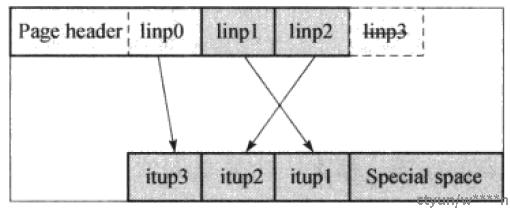
索引页面组织结构图2(图片来源于PG数据库内核分析书籍)
- 节点为最右节点:对于最右节点,其并不需要HK,故将每个linp递减一个位置,linp3不再使用。
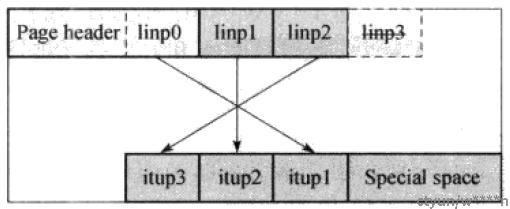
索引页面组织结构图3(图片来源于PG数据库内核分析书籍)
- 根据上面的描述,可以得出一个完整的索引组织结构图:
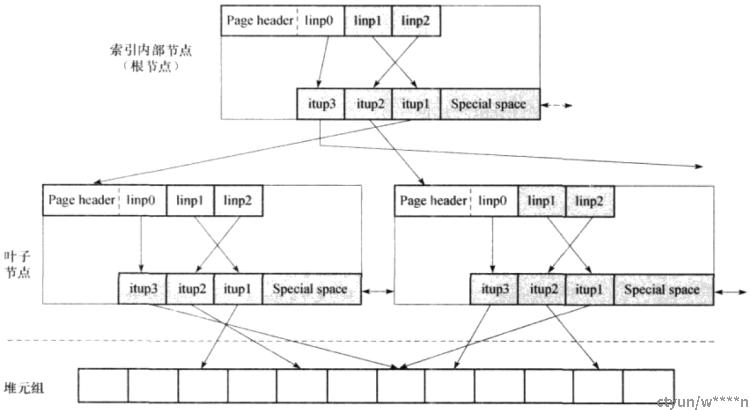
索引整体组织结构图(图片来源于PG数据库内核分析书籍)
- 虚线上方为索引结构:
- 根节点和内部节点层:索引元组指向索引节点。
- 叶子节点:索引元组指向表元组的存放的实际位置。
- 根据BTree的特性,索引元组为有序,第一个叶子节点中itup3实际为最大索引元组,即HK,第二个叶子节点中itup1实际为最小索引元组,两者相同,故指向了同一物理存储位置。
- 虚线下方为表元组
3.2. B-tree构建过程
3.2.1. 数据结构介绍
- IndexAmRoutine 结构体规定了制作索引需要定义的属性,以及实现的方法
- BtHandler的实现如下
- BTBuildState结构体主要保存索引元组
- BTWriteState结构体主要保存块号信息等
- BTPageState主要保存节点层次信息,以及指向父节点层次的指针
3.2.1.
/*
* API struct for an index AM. Note this must be stored in a single palloc'd
* chunk of memory.
*/
typedef struct IndexAmRoutine
{
NodeTag type;
/*
* Total number of strategies (operators) by which we can traverse/search
* this AM. Zero if AM does not have a fixed set of strategy assignments.
*/
uint16 amstrategies;
/* total number of support functions that this AM uses */
uint16 amsupport;
/* opclass options support function number or 0 */
uint16 amoptsprocnum;
/* does AM support ORDER BY indexed column's value? */
bool amcanorder;
/* does AM support ORDER BY result of an operator on indexed column? */
bool amcanorderbyop;
/* does AM support backward scanning? */
bool amcanbackward;
/* does AM support UNIQUE indexes? */
bool amcanunique;
/* does AM support multi-column indexes? */
bool amcanmulticol;
/* does AM require scans to have a constraint on the first index column? */
bool amoptionalkey;
/* does AM handle ScalarArrayOpExpr quals? */
bool amsearcharray;
/* does AM handle IS NULL/IS NOT NULL quals? */
bool amsearchnulls;
/* can index storage data type differ from column data type? */
bool amstorage;
/* can an index of this type be clustered on? */
bool amclusterable;
/* does AM handle predicate locks? */
bool ampredlocks;
/* does AM support parallel scan? */
bool amcanparallel;
/* does AM support columns included with clause INCLUDE? */
bool amcaninclude;
/* does AM use maintenance_work_mem? */
bool amusemaintenanceworkmem;
/* OR of parallel vacuum flags. See vacuum.h for flags. */
uint8 amparallelvacuumoptions;
/* type of data stored in index, or InvalidOid if variable */
Oid amkeytype;
/*
* If you add new properties to either the above or the below lists, then
* they should also (usually) be exposed via the property API (see
* IndexAMProperty at the top of the file, and utils/adt/amutils.c).
*/
/* interface functions */
ambuild_function ambuild;
ambuildempty_function ambuildempty;
aminsert_function aminsert;
ambulkdelete_function ambulkdelete;
amvacuumcleanup_function amvacuumcleanup;
amcanreturn_function amcanreturn; /* can be NULL */
amcostestimate_function amcostestimate;
amoptions_function amoptions;
amproperty_function amproperty; /* can be NULL */
ambuildphasename_function ambuildphasename; /* can be NULL */
amvalidate_function amvalidate;
amadjustmembers_function amadjustmembers; /* can be NULL */
ambeginscan_function ambeginscan;
amrescan_function amrescan;
amgettuple_function amgettuple; /* can be NULL */
amgetbitmap_function amgetbitmap; /* can be NULL */
amendscan_function amendscan;
ammarkpos_function ammarkpos; /* can be NULL */
amrestrpos_function amrestrpos; /* can be NULL */
/* interface functions to support parallel index scans */
amestimateparallelscan_function amestimateparallelscan; /* can be NULL */
aminitparallelscan_function aminitparallelscan; /* can be NULL */
amparallelrescan_function amparallelrescan; /* can be NULL */
} IndexAmRoutine;/*
* Btree handler function: return IndexAmRoutine with access method parameters
* and callbacks.
*/
Datum
bthandler(PG_FUNCTION_ARGS)
{
IndexAmRoutine *amroutine = makeNode(IndexAmRoutine);
amroutine->amstrategies = BTMaxStrategyNumber;
amroutine->amsupport = BTNProcs;
amroutine->amoptsprocnum = BTOPTIONS_PROC;
amroutine->amcanorder = true;
amroutine->amcanorderbyop = false;
amroutine->amcanbackward = true;
amroutine->amcanunique = true;
amroutine->amcanmulticol = true;
amroutine->amoptionalkey = true;
amroutine->amsearcharray = true;
amroutine->amsearchnulls = true;
amroutine->amstorage = false;
amroutine->amclusterable = true;
amroutine->ampredlocks = true;
amroutine->amcanparallel = true;
amroutine->amcaninclude = true;
amroutine->amusemaintenanceworkmem = false;
amroutine->amparallelvacuumoptions =
VACUUM_OPTION_PARALLEL_BULKDEL | VACUUM_OPTION_PARALLEL_COND_CLEANUP;
amroutine->amkeytype = InvalidOid;
amroutine->ambuild = btbuild;
amroutine->ambuildempty = btbuildempty;
amroutine->aminsert = btinsert;
amroutine->ambulkdelete = btbulkdelete;
amroutine->amvacuumcleanup = btvacuumcleanup;
amroutine->amcanreturn = btcanreturn;
amroutine->amcostestimate = btcostestimate;
amroutine->amoptions = btoptions;
amroutine->amproperty = btproperty;
amroutine->ambuildphasename = btbuildphasename;
amroutine->amvalidate = btvalidate;
amroutine->amadjustmembers = btadjustmembers;
amroutine->ambeginscan = btbeginscan;
amroutine->amrescan = btrescan;
amroutine->amgettuple = btgettuple;
amroutine->amgetbitmap = btgetbitmap;
amroutine->amendscan = btendscan;
amroutine->ammarkpos = btmarkpos;
amroutine->amrestrpos = btrestrpos;
amroutine->amestimateparallelscan = btestimateparallelscan;
amroutine->aminitparallelscan = btinitparallelscan;
amroutine->amparallelrescan = btparallelrescan;
PG_RETURN_POINTER(amroutine);
}/*
* Working state for btbuild and its callback.
*
* When parallel CREATE INDEX is used, there is a BTBuildState for each
* participant.
*/
typedef struct BTBuildState
{
bool isunique;
bool nulls_not_distinct;
bool havedead;
Relation heap;
BTSpool *spool;
/*
* spool2 is needed only when the index is a unique index. Dead tuples are
* put into spool2 instead of spool in order to avoid uniqueness check.
*/
BTSpool *spool2;
double indtuples;
/*
* btleader is only present when a parallel index build is performed, and
* only in the leader process. (Actually, only the leader has a
* BTBuildState. Workers have their own spool and spool2, though.)
*/
BTLeader *btleader;
} BTBuildState;/*
* Overall status record for index writing phase.
*/
typedef struct BTWriteState
{
Relation heap;
Relation index;
BTScanInsert inskey; /* generic insertion scankey */
bool btws_use_wal; /* dump pages to WAL? 是否开启wal */
BlockNumber btws_pages_alloced; /* # pages allocated 记录下一次申请page的块号*/
BlockNumber btws_pages_written; /* # pages written out 已经写入文件的页面块号*/
Page btws_zeropage; /* workspace for filling zeroes */
} BTWriteState;/*
* Status record for a btree page being built. We have one of these
* for each active tree level.
*/
typedef struct BTPageState
{
Page btps_page; /* workspace for page building */
BlockNumber btps_blkno; /* block # to write this page at */
IndexTuple btps_lowkey; /* page's strict lower bound pivot tuple */
OffsetNumber btps_lastoff; /* last item offset loaded */
Size btps_lastextra; /* last item's extra posting list space */
uint32 btps_level; /* tree level (0 = leaf) */
Size btps_full; /* "full" if less than this much free space */
struct BTPageState *btps_next; /* link to parent level, if any */
} BTPageState;3.2.2. 构建流程
- 整体过程:首先将待索引的表元组封装为索引元组,并对索引元组进行排序,然后将排好序的索引元组填充到当前叶子节点中,若当前叶子节点填充满,则新申请一个叶子节点作为当前叶子节点的右兄弟节点,然后在父节点中添加指向新叶子节点的指针(没有父节点则创建),接下来把新申请的节点当作叶子节点。重复这个过程,直到添加完成所有的索引元组为止。
- 创建索引流程图
- indexBuildHeapScan函数为BTBuildState结构体中的spool1 2赋值。
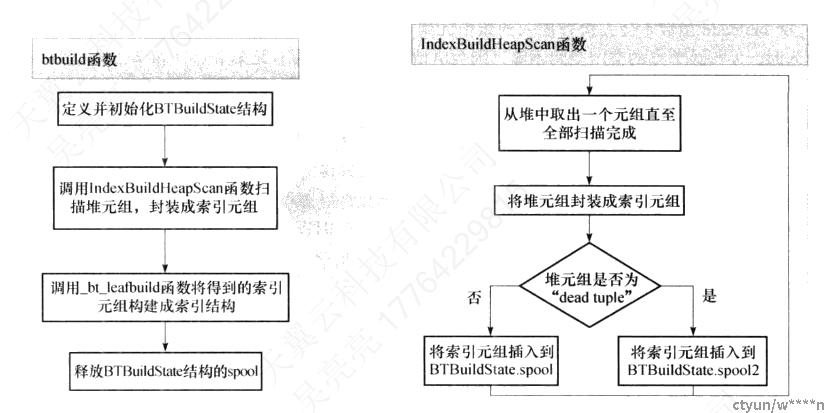
构建流程图1(图片来源于PG数据库内核分析书籍)
- 生成索引结构流程图

构建流程图2(图片来源于PG数据库内核分析书籍)
- 插入索引元组流程和实例图(假设一个页面最多两个元组)
- add函数插入时发现空间不够,则申请新的页面作为右兄弟节点,然后设置旧节点HK。
- 接着通过当前层次的BTPageState.btps_next找到父节点(若没有则创建),将旧节点的min key插入到父节点(同样使用add函数,递归调用),然后设置新旧节点的兄弟关系。
- 旧节点填充完成不会再修改,此时调用_bt_blwritepage将旧节点信息写入索引文件,并修改BTWriteState结构。
- 最后调用_bt_sortaddtup将待插入的索引元组插入到节点(若右有足够空间直接调用次函数)

构建流程图3(图片来源于PG数据库内核分析书籍)
- 上述得到了初步的索引结构,但每层最右节点与父节点的连接还没完成,因此使用_uppershutdown函数进行调整
- BTPageState结构中有指向上一层的BTPageState结构,通过这个结构依次调整最右节点和父节点

构建流程图4(图片来源于PG数据库内核分析书籍)
3.2.3. 插入流程
- 插入背景:表已经创建索引,现在插入新的元组,索引也需要调整,使用btinsert实现。
- btinsert过程:往下找到合适的插入节点(若是唯一索引,则验证),将其插入到索引中。
- 找合适节点的过程中,会利用BTStackData保存查询过程中的父节点(保存查询路径),便于插入操作需要分裂叶子节点时,可以根据次结构找到父节点,并对父节点做出调整。
- 当需要分裂时,需要找到合适的分裂位置,保证左右节点的剩余空间合理(PG规定,若是最右节点,分裂后产生的右节点应为左节点剩余空间的两倍,否则相等,也可以在创建索引时指定fillfactor填充因子)。
- 插入索引元组的流程图。
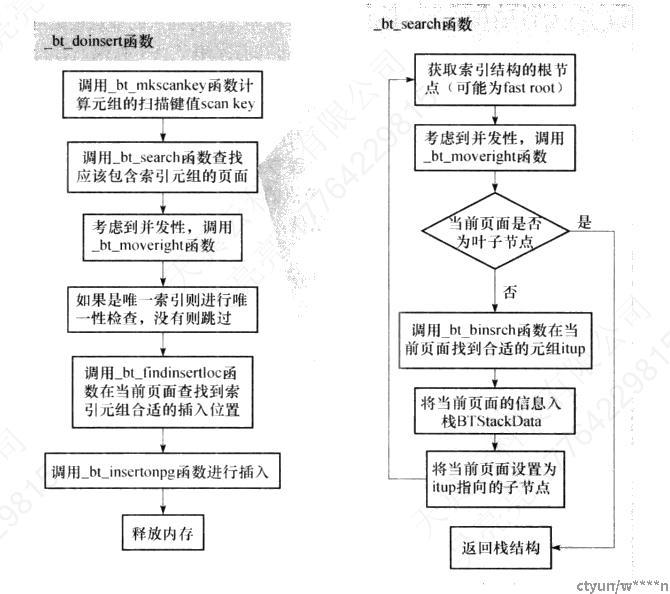
插入流程图(图片来源于PG数据库内核分析书籍)
- _bt_moveright是根据L&Y的论文实现的,通过 _bt_moveright 检测当前操作的页面是否有并发insert 导致 page-split 的情况。如果发现查找 的key 大于页面的 high-key,则通过页面的右指针移动到其兄弟节点。
- _bt_findinsertloc不会局限于当前的节点,还会到右兄弟节点中查找。
- _bt_insertonpg执行插入操作,检查是否有足够的剩余空间,如果有直接插入,如果没有,则调用_bt_findsplitloc寻找最合适的分裂位置,然后进行分裂操作,最后插入元组。
4. 总结
- 本篇简单介绍了索引概念、分类,并展示了索引的相关实践。
- 关于索引的原理,主要是以Btree为主,阐述了PG中Btree的背景以及构建过程。
- 篇幅和时间原因,没有描述函数具体实现和delete元组的操作。